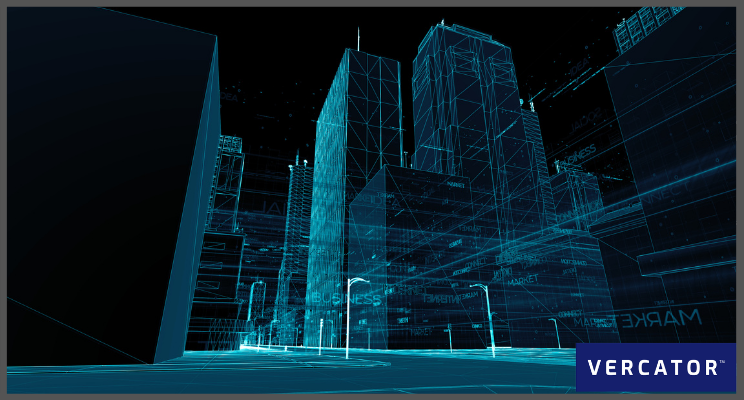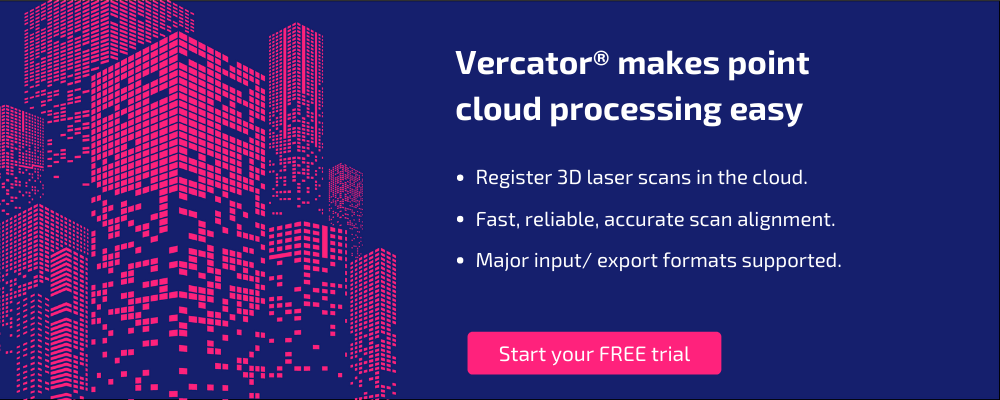Future trends in laser scanner technology

Laser scanning is on a path to become more powerful, more useful, and more affordable — impacting a vast array of industries. Following a similar trajectory to computing, the technology is simply becoming smaller , cheaper and easier to use.
Here, we want to will highlight:
- How laser scanners have advanced recently
- Known areas of investment for the future
- The likely way the technology will change,
- How you can put these changes to good use.
Primarily used by surveyors, laser scanners and laser scan datasets have become increasingly vital to a growing number of industries — specifically construction. Not only will the technology change, but even how it's used and who benefits will evolve dramatically.
1. The expansion of LiDAR and growth of mobile LiDAR
LiDAR (Light Detection and Ranging) is the dominant technology and technique behind most laser scanning. It works by shooting powerful laser pulses towards the target and collecting the backscattering signal. These systems are the current mainstream and use a selection of spectral wavelengths to collect data.
Historically, LiDAR scanners have been static devices, requiring set up — and even the use of stationary registration targets. Additional reading: If you want to learn more about targetless registration, check out our free eBook — Point Cloud Processing Has Changed.
But mobile scanning using this same technology is growing in accessibility and effectiveness. In fact, it’s poised to entirely change how we approach scanning.
SLAM (Simultaneous Localisation and Mapping)
SLAM is the algorithmic process of building a map of an unknown environment while simultaneously navigating that environment using the map. It’s a tricky problem to solve, but is one that is critical to advanced autonomous robotics, and promises to make mobile scanning simple and easy.
SLAM scanners can deploy a range of different sensor types — including acoustic rangefinders, visual cameras and inertial sensors. However, LiDAR and laser scanners are a critical component of producing the most precise SLAM scans, and will see increased use and deployment in the near future. Brands like GeoSlam, Paracosm and NavVis already have handheld scanners on the market that enable surveyors to simply walk through a site and collect all of the relevant data that they need. This development is made possible by a coming-together of a range of technologies including the miniaturisation of sensors and improvements to LiDAR odometry and mapping (LOAM).
Drones
Unmanned aerial systems (UASs) are increasingly important in scanning — both outside and inside. This is being done with SLAM scanners, along with traditional LiDAR and GPS-enhanced LiDAR.
Mapping and surveying drones provide an easy-to-deploy platform for aerial views. Currently, some factors are limiting the use of drones regarding operation time and the development of regulations in many countries. At their best, drones contribute to the production of valuable 3D and image data needed in various engineering projects, urban planning and scientific tasks. Longer operational times for UAVs are being delivered by improved avionics and battery life.
Why is this important
Point cloud models have massive potential if they can escape their static origins. Extracting as much value as possible from scans will lead to the "democratisation of the point cloud".
- Drones will contribute to the production of valuable 3D and image data for various engineering projects, urban planning and scientific tasks.
- SLAM will enable fast and accurate mapping where GNSS (GPS) localisation is unavailable, such as indoor spaces.
Strategies for Adoption
Introducing new models and techniques into your projects is a learning curve. SLAM is a great place to start. The scanners are increasingly affordable, and there are not the same regulatory restrictions when compared to getting started with drone technology. By adopting and trialling this technology early you can develop effective ways to integrate it into your workflow and benefit from the competitive advantage.
Pro tip: SLAM scan data is not as precise as static laser scans. It’s important to have ways to integrate SLAM data with other data sources in order to make sure that you can take advantage of the speed of SLAM scanning while still delivering the level of detail and accuracy required for the project.
Suggested reading: A 2021 SLAM Update For Surveyors.
2. The spread of point clouds into the cloud
Data availability, accuracy, density, and size of 3D point clouds are forecast to grow rapidly within the next few years. The increasing use and volume of point clouds will see an explosion in the need to manage data in the cloud — cloud-based processing of data and direct field upload of point cloud data to cloud services will likely become the norm.
Why this is important
The cloud brings two distinct advantages to point clouds. The traditional benefit centres around the storage and sharing of information and models. Rather than having to send outputs to all of the relevant stakeholders, access can simply be granted and all of the relevant parties can view common files. Cloud storage can also be dynamically scaled, and offers a cheap way to increase capacity for a large project. This is very similar to how Building Information Modelling (BIM) is improving general collaboration in construction.
Maybe of greater importance, however, are the benefits that that cloud brings to processing and registration. Point cloud processing has always been a stumbling block preventing the wider-spread usage of laser scanners for reality capture. The time required to process those scans drives up costs, limiting effective applications.
Advances in point cloud algorithms are dramatically changing this reality. More robust, vector-based and multi-stage processing enables the front-loading of manual tasks, and the automation of large sections of processings. By itself, this delivers processing acceleration. But the right laser scanning software enables you to take advantage of parallel computing — registering multiple scans simultaneously using multiple processors. This can only scale so far using on-premise hardware. However, the cloud offers near-limitless scalability — delivering far faster registration and more robust outcomes.
Strategies for adoption
To take real advantage of the cloud, you need to re-think your processes. The full value of cloud will come from approaching point cloud processing not as a one-off tactical decision but as part of a strategy to pursue digital transformation overall. You need to think about processes changes and technological investments — critically, the right processing software.
Suggested reading: Are You Ready For The Cloud? A Surveyor’s Guide to the Future of 3D Laser Scanning
3. The advent of multimodal scans
More and more, scanning, sensor and visual data are being combined to provide a more complete picture. As we’ve already touched on, SLAM data can be used in conjunction with static laser scanners to quickly gain total scene coverage while focusing details only on the areas that matter. This can also be done combining UAV-based airborne sensors with terrestrial datasets. With all of these examples, it’s also possible to include colour fills or data derived from imagery to add additional details. Ultimately, the outcome is more detailed scans produced faster with the right tools deployed for each individual job.
Why this is important
There are many reasons a project could require a multimodal scan. Sometimes, the shape and height of an object makes scanning the top of a target difficult. In other cases, the area is too large to survey with a terrestrial LiDAR unit. Or, you simply want multiple data types to get the kind of coverage needed. In all cases, the more complete the scan can be, the more you can trust it as the "one-source-of-truth" now needed for large scale projects.
Strategies for adoption
It’s worth investigating novel scanning techniques and technologies and evaluating how they can be incorporated into your “business as usual” approach. Look at cloud-based registration software to make the task easier by knitting together these scans into a complete view. Fundamentally, you need to make sure that you have tools that are able to combine data sets and then deliver that as a single output.
4. AR/VR integrating with laser scanning
While augmented reality and virtual reality can be considered as an output of scanning technology, developments in this area will also drive its future. Reviewing scan data with AR/VR will become more common — particularly for client stakeholders. And you can see the merger of this kind of technology in a number of different places, even the consumer market.
For example, Apple has already released an iPhone with a built-in LiDAR scanner. With a laser-aided, 3D depth mapping system, future iPhones will be able to scan entire rooms, and more accurately represent the position of computer-generated objects in the real world. This can and will be combined with gaming, home decorations and more. As consumer products drive technological advancements, this will only improve the integrations available to professionals.
Why this is important
Interest in and development of AR/VR technologies has ebbed and flowed since initial experiments in the late 1950s. The iPhone LiDAR scanner is a pointer to the future. It doesn't currently let you 3D scan objects with greater accuracy than other techniques like photogrammetry. But it will act as a catalyst to open up future uses in building fit-out, education, health and retail.
Strategies for adoption
Research indicates that training and education were favoured to be the first areas to benefit from AR/VR applications in construction. If you are involved in this area, it may be worth looking at how laser scanning output could be incorporated in training and safety work.
Modelling the future
The story of laser scanners is not too different from most evolving technologies — they are becoming better, cheaper and smaller. The real change is to the use cases. As any technology matures it becomes more easily accessible and new ways to apply that technology become viable.
The expansion of applications for laser scanners is already starting. Driven by smaller and cheaper scanners, armed with improvements in point cloud registration, laser scanning technology is becoming integral to many engineering and construction projects and will continue to be so. Ultimately, you need to look at the possibilities and get creative. As the LiDAR becomes a commodity, the possibilities are nearly limitless.
Suggested reading: The Complete Guide to 3D Laser Scanning Software.
Tags: laser scanner


